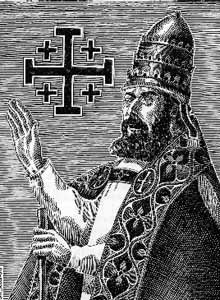 Blue blood of
blue bloods was Guy of Vienne who became Calixtus II. Guy was born probably at
Quingey in 1060, the son of William, count of Burgundy. By blood or marriage he
was related to Emperor Henry V, Henry I of England, Louis VI of France, and
Alfonso VII of Castile. Guy became a priest when quite young and soon rose to be
archbishop of Vienne. He acted as legate for Paschal II and held a council at
Vienne which boldly excommunicated Henry V when that monarch wrested the
privilege of lay investiture from poor Paschal.
Blue blood of
blue bloods was Guy of Vienne who became Calixtus II. Guy was born probably at
Quingey in 1060, the son of William, count of Burgundy. By blood or marriage he
was related to Emperor Henry V, Henry I of England, Louis VI of France, and
Alfonso VII of Castile. Guy became a priest when quite young and soon rose to be
archbishop of Vienne. He acted as legate for Paschal II and held a council at
Vienne which boldly excommunicated Henry V when that monarch wrested the
privilege of lay investiture from poor Paschal.
The council urged Paschal to confirm its decrees and hinted that he had better
do so--or suffer worse! Since Paschal did so, there was no trouble; but the
incident reveals a lack of perfection in Guy's obedience and loyalty. He was,
however, a strong reform bishop and a popular one. Elected pope by the cardinals
at Cluny, Guy was most reluctant to accept; but finally all objections were
overruled and he was enthroned at Vienne on February 9,1119, as Calixtus II. The
outstanding event of this pontificate was the settlement of the lay investiture
quarrel. While Calixtus captured Henry's antipope at Sutri, Henry was meeting
much opposition in Germany. And all this time a great tide of public opinion
favoring a peaceful settlement was rising swiftly. After some preliminary
negotiations, Henry held a great diet at Worms in September 1122 to discuss the
matter. After heated discussions, the papal legates and the Emperor drew up a
concordat or agreement between Church and State. By this concordat the Emperor
renounced the right of investiture by ring and crozier, thus conceding the
independence of the spiritual power. The Pope allowed investiture by scepter as
a symbol of the temporal fiefs connected with the bishopric or abbey. Thus while
the principle of spiritual independence was saved, the legitimate rights of
civil rulers to some control over fiefs was safeguarded.
The Emperor guaranteed free elections, but the Pope agreed that the Emperor
could be present at elections, a concession which could easily make free
elections a mockery The Concordat of Worms was hailed as a victory for the
Church and sent papal prestige skyrocketing. In cold sober fact it left the
Church still far too open to secular control. At any rate Henry was released
from censures, and men rejoiced in the peace that followed. In March 1123
Calixtus held the ninth ecumenical council, the First Lateran. This, attended by
over 300 bishops and 600 abbots, confirmed the Concordat of Worms. It passed the
usual reform decrees and one striking new one. Before this, if a priest married,
the marriage, though illicit and sinful, was valid. Now such a marriage was
declared null and void; in other words, no marriage. Calixtus II favored St.
Norbert and approved the Premonstratensian order. He also approved the Knights
of St. John or Hospitallers, that famous crusading order. An able spiritual
ruler, Calixtus proved also a capable king. Heads literally rolled when he
stormed the castles of lawless Roman lords. Even in turbulent Rome itself there
was a momentary pause in the clash of arms. No wonder an old chronicler calls
Calixtus II, "the father of peace." Calixtus II died on December 13, 1124.
Excerpted from "Popes
Through the Ages" by Joseph Brusher, S.J.

